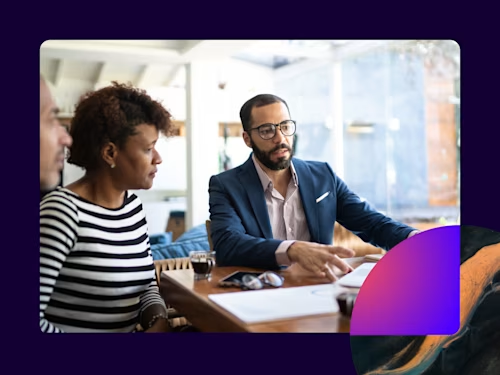
How InfoTrack and The Partnership are using Docusign eSignature to overhaul conveyancing processes
The Land Registry started accepting e-signatures in July and within two days InfoTrack and The Partnership had launched the first AP1 transfer digitally.
- Can you tell us a bit about InfoTrack and The Partnership?
- Why did InfoTrack decide to become a Docusign API partner?
- What was it that ultimately drove you to choose Docusign eSignature over other solutions?
- What is the biggest advantage of electronic signing?
- How is eSignature being used at The Partnership?
- Why do you think InfoTrack and The Partnership were the first to use Docusign eSignature to digitally lodge a signed transfer?
- Why is digital transformation important to your business?
- Do you have any metrics on time and costs saved since implementing eSignature?
- Do you have any future digital initiatives for your company or a specific department that Docusign will be a part of?
- What's next for InfoTrack?
- How can you see Docusign eSignature being used in future conveyancing?
Table of contents
- Can you tell us a bit about InfoTrack and The Partnership?
- Why did InfoTrack decide to become a Docusign API partner?
- What was it that ultimately drove you to choose Docusign eSignature over other solutions?
- What is the biggest advantage of electronic signing?
- How is eSignature being used at The Partnership?
- Why do you think InfoTrack and The Partnership were the first to use Docusign eSignature to digitally lodge a signed transfer?
- Why is digital transformation important to your business?
- Do you have any metrics on time and costs saved since implementing eSignature?
- Do you have any future digital initiatives for your company or a specific department that Docusign will be a part of?
- What's next for InfoTrack?
- How can you see Docusign eSignature being used in future conveyancing?

The disruptions of 2020 are changing how buyers buy, and sellers sell. In July 2020, the HMLR issued guidance allowing for witnessed electronic signatures (WES).
This has been an eagerly anticipated reform, especially in the wake of COVID-19 when the need for a digital alternative reached a tipping point. Printing, posting and scanning documents is not always feasible, including in the context of witnessing.
InfoTrack (a company that crucially connects law firms, their clients and Case Management through technology) and The Partnership (a leading property solicitors firm) came together to submit the first property deeds to be signed electronically using Docusign eSignature. This was an industry first and blazed the trail for the digital transformation of conveyancing, a traditionally conservative industry.
Here we catch up with Scott Bozinis, CEO of InfoTrack, and Peter Ambrose, Managing Director of The Partnership. We discuss the significance of the Land Registry’s decision and how eSignature is helping to transform the work they do.
Can you tell us a bit about InfoTrack and The Partnership?
Scott: InfoTrack is a global business that enables customers to perform key conveyancing on one platform. My role within that is heavily based around digitising conveyancing and its processes. Our clients are law firms and conveyancers and our mission is to take tedious and time-consuming tasks and consolidate them into one easy-to-use platform.
Peter: The Partnership is a leading property law firm, recognised as the market leader for their use of technology within the conveyancing process. We have offices in London and Guildford employing around 75 people and focus purely on the London and the southeast property market. My role within the company is to drive strategic thinking in terms of where we go next, how we roll out our technology to help bring efficiency to our business. One of our key goals is to reduce the friction we currently see within the conveyancing process and get properties transacting more quickly.

Why did InfoTrack decide to become a Docusign API partner?
Scott: InfoTrack is a global business who has partnered with Docusign and is using Docusign eSignature in the company’s UK, US and Australian businesses. We aim to provide law firms with one technology partner for many different solutions.
We saw a gap in the market where we could help law firms sign documents.
Docusign is the biggest and strongest provider in the market so it made sense to become a partner. We use an API because we want to take Docusign eSignature and embed it deeply in conveyancing and legal workflows. Through the API we can create a more bespoke service for conveyancing and areas of law.
What was it that ultimately drove you to choose Docusign eSignature over other solutions?
Scott: Lawyers are conservative because they are dealing with sensitive information and the security of their documents is crucial.

What is the biggest advantage of electronic signing?
Peter: It makes a huge, huge difference, particularly around the most critical times of the deals. For example, when you're getting close to exchange and you need to have deeds signed and witnessed.
We looked into some of the stats of how long it was taking us—at least a week just to get this bit of paperwork signed and witnessed. In particular, having someone witness a document has been a big problem, especially during lockdown.
When we did the first electronic deed signature, we got it signed and witnessed within five minutes.
So a process that typically took a week and frankly people found really annoying was then made really, really simple. So speed is crucial but the other, and possibly more important, is security.
Everyone talks about wet signatures as being the gold standard when it comes to security, but we have not found that to be true. Five years ago, a client of ours got their email hacked. Someone copied their (wet) signature and stole £300,000 from them.
We know eSignature would have avoided that fraud, so speed is important, but it's the security that really drives it home.
Scott: In a COVID-19 world we can’t have people coming to our offices to sign documents. Our staff work remotely–they don’t have printers and scanners. This adds another benefit because posting and scanning is even harder. It further lends itself to digital solutions.
Peter: That’s a really important point. What we didn't realise going into lockdown was how many people used printers at work to print, sign and scan documents. People tell us, ‘I’ve got no way of printing this. I've got a document, but I can't do anything with it.’ It is literally a dead stop. So documents had to be posted, which caused huge delays as well as additional, unnecessary costs.
How is eSignature being used at The Partnership?
Peter: For us, electronic document transfers are key. For security reasons, for the last three years, we stopped using emails with clients, and instead used our own portal. We certainly don't use paper.
We were looking for a solution to get documents and paperwork signed electronically. We chose Docusign eSignature before the Land Registry’s decision to accept e-signatures–something we were delighted to hear as we think that electronic signatures are the way forward.
Now we use Docusign eSignature for the deeds, which we believe is the most critical part of the exchange. We are looking to roll this out to other documents too.
Why do you think InfoTrack and The Partnership were the first to use Docusign eSignature to digitally lodge a signed transfer?
Scott: Peter and I met at a corporate dinner one evening where we bonded over the use of technology in conveyancing. We both come from technology backgrounds, and I think it's driven us to become friends through business and utilise technology.
It was a no-brainer for us. When the land registry announced it was accepting e-signatures, we wanted to build this and be the first.

From an agility perspective, we're very proud that it took two days to get that done and that property has now been legally registered and has gone through. It’s our passion for using technology to solve problems that drove this.
Why is digital transformation important to your business?
Peter: It's vital. We deal with a lot of clients and we typically transact about 300 properties a month, a number that is quickly increasing. We wouldn't be able to do that without digital transformation. With the quality of service that we provide you would normally need a firm twice our size. What technology does for us generates incredible efficiencies.
We couldn't be as profitable, or as successful as we are today without digitisation.
Do you have any metrics on time and costs saved since implementing eSignature?
Scott: The bottom line is, if my client is in Spain and they’re a property owner (and that’s common in Europe) I physically have to post the transfer to them.
Peter: We’ve got a client at the moment who lives in Australia, where all post is blocked from there. Before Docusign eSignature, to get that done, it would take at least a week for something we can now do in five minutes. It’s almost incalculable. In the past, the client would have to print out the document and courier it to us.
Scott: It is. The time cost, the cost of an international courier, and the cost to the environment.
Peter: The cost of the courier is really expensive. In addition, every piece of paper has to be stored for 12 years.
Do you have any future digital initiatives for your company or a specific department that Docusign will be a part of?
Scott: InfoTrack is deep in the development of onboarding solutions to help law firms onboard their clients digitally. A key part of any onboarding process is accepting the terms and conditions of the contract which needs a binding signature. We use Docusign eSignature for that process.
What's next for InfoTrack?
Scott: Providing the industry with an end-to-end digital conveyancing solution. We can now provide the market with digital conveyancing from onboarding, through searching, through electronic document registration with signatures, to the AP one transfer digitally. We will continue to work on building into an end-to-end digital conveyancing solution.
How can you see Docusign eSignature being used in future conveyancing?
Peter: It will be used more widely by lawyers as they start to gain trust in it as a medium. I think it's the start of a movement. Land Registries are known for being very cautious and sensible when it comes to securing data, so as they drive this it will gain credibility amongst law firms. It has to be the future. It's not a question of if, but when—and Docusign will be at the forefront of this movement.
Scott: The conveyancing process requires typically 10-15 documents to be signed. Normally, you have to go and see your lawyer to do this. With Docusign eSignature, these documents can be bundled into one envelope and signed in one go–saving users from having to physically sign the documents.
Learn how you too can reduce time and effort collecting signatures, whilst following the HMLRs latest guidelines. Register for our webinar this Wednesday, 14th October.
Scott and Peter will join us to discuss in detail how they made conveyancing history by making the first electronic HMLR submission.
Related posts
Docusign IAM is the agreement platform your business needs



